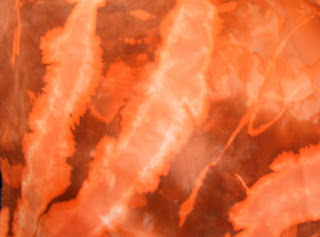Tuesday, February 14, 2012
Getting Technical, or The Art Of Dyeing.
I said I would revisit some of the dyeing terms I used yesterday. If you haven't tried dyeing before, you might be thinking of the immersion style of dyeing, when you put dye into a lot of water, and then stick your fabric in, swish it around regularly and hey presto! the fabric is another colour. That works really well for single colours, but what if you want to have more than one colour in a cloth? Clearly, pouring three colours into a bucket of water is going to produce...well... mud, probably. A grey, or a brown. You have no way of keeping the colours separate. And of that desire, low immersion was born. You use a lot less water, and introduce the colours carefully to the cloth, so that you get the kind of results that you saw yesterday, and in the cloth pictured above. I'd like to say that there's a lot more to it than that, but, other than getting the chemistry right (ie, adding the soda ash at the right time), that's really all there is to it. The dye travels around the cloth, mixing as it choses, with a little white cloth left in places where the dye hasn't quite managed to reach.
Taking low immersion cloth out of the container it has been dyed in is always thrilling. You never really know what you have created, until it is out of there, rinsed and washed. You do get some wonderful surprises, and the occasional shock. The good thing, though, is that no matter how unhappy you are with a piece of cloth, you can always overdye it to create something you are happier with. It is a very forgiving medium.
But what if you want to make patterns in your dyed cloth? There are lots of ways of doing that, of course, but the one I mentioned yesterday is discharge dyeing. That involves taking a piece of dyed cloth and removing dye from it, usually with bleach. You then neutralise the bleach and admire the results. The images here are of brown cotton sateen cloth that has been discharge dyed using bleach. I wanted to have a really organic, natural look, so the marks are fairly random. In the piece, the result is really impressive; however, cloth like this is always really interesting cut into strips and then reassembled. Think of the look of a traditional block using fabric like this... really unusual.
So there you are, yesterday's technical terms, explained. Any questions?
Subscribe to:
Post Comments (Atom)



No comments:
Post a Comment